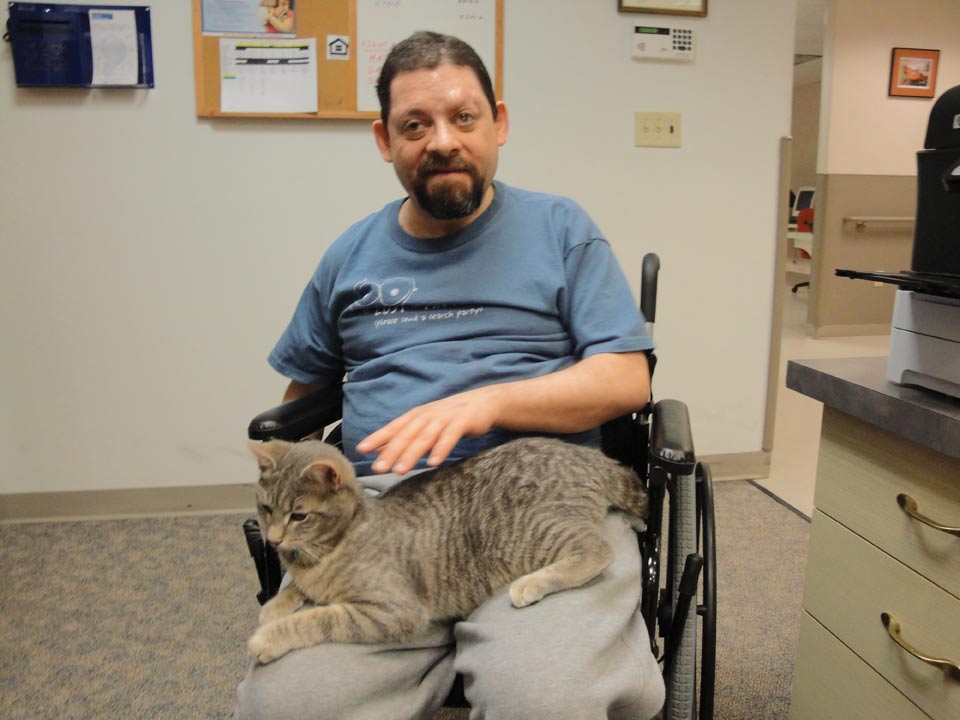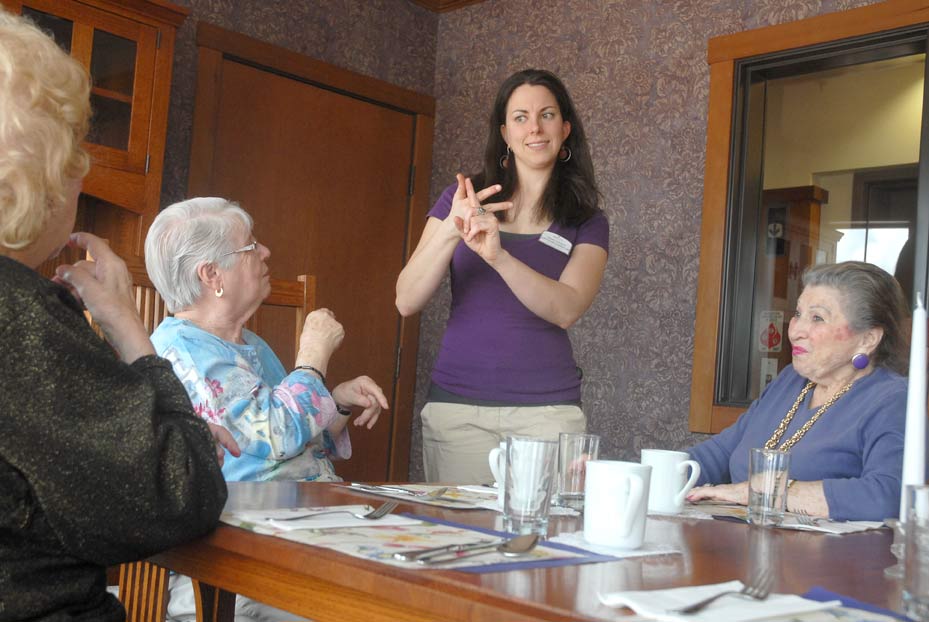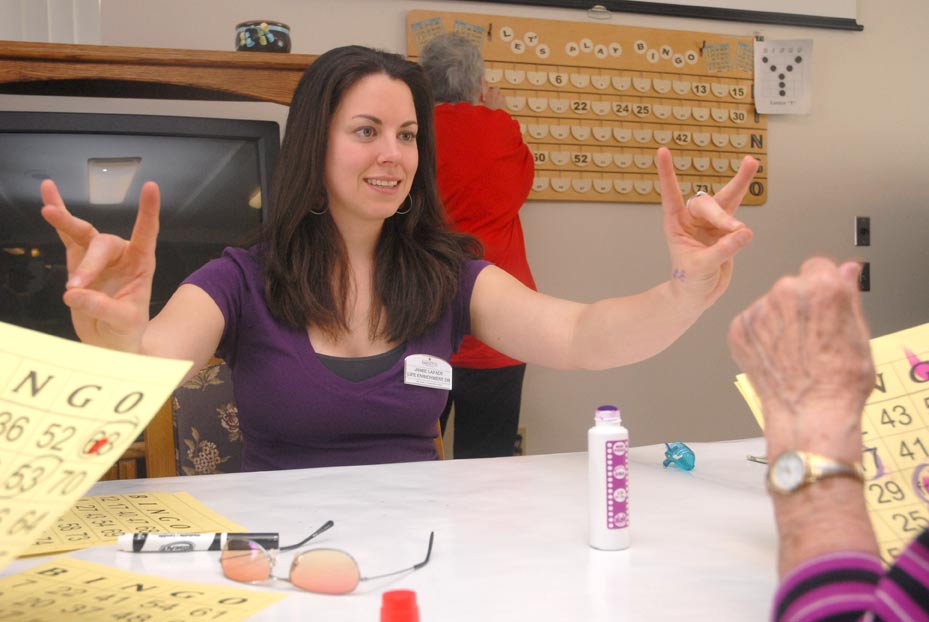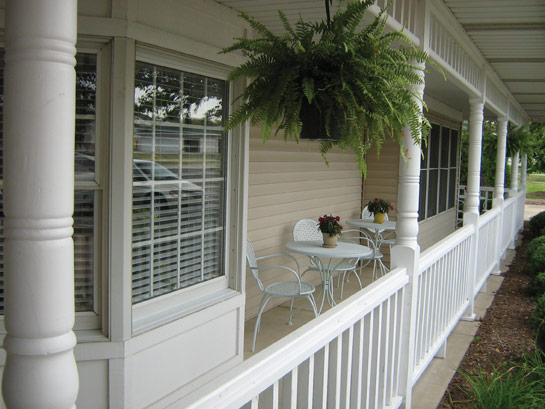A woman who had previously lived in a trailer with no running water, no heat, and a bucket for a toilet now has a warm and comfortable home at a Maine assisted living community. An elderly woman, who was deaf and in need of assistance that her daughter could no longer provide, was welcomed into her new home by housemates and staff who communicated in her native sign language. Then there's a man who was seriously injured in a motorcycle accident but previously had no one to help him get dressed in the morning.
These individuals have found their homes in assisted living communities, and all are supported by Medicaid and/or Social Security in some form.
The communities that support these residents and thousands of others like them are scattered across the country, from Oregon to Maine, and their missions are to offer solace, support, and a place to call home. In many cases, these individuals need care and services that do not rise to the level of skilled or long-term nursing but include some type of round-the-clock assistance.
Although the extent to which assisted living providers have opted to take on specialty care is not known, anecdotal evidence suggests that many have recently embraced the concept and carved out niche service offerings for clients with specific diagnoses or for those who simply want to stay in their homes for as long as possible.
To that end, these providers are, in many cases, meeting unmet housing needs for people who might otherwise be homeless or in a nursing facility. And many of their residents have grown to adulthood and beyond and no longer have parents or loved ones to care for, supervise, or support them.
Because these communities are filling the gaps left by housing shortages, they are often full and have long waiting lists to get in.
The individuals who are making their homes in these communities have diagnoses that range from severe mental illness, Parkinson’s disease, HIV-AIDS, acquired brain injury, multiple sclerosis, autism, and those who are deaf and deaf-blind.
In these pages, Provider takes readers into several communities for a look at how they have successfully taken the road less travelled and why they will never turn around.
Mission-focused Assisted Living Staff
Employees of specialty care homes are generally not shy about professing their love for the residents. The staff of Washington Manor, an assisted living community located in the tiny hamlet of Washington, Maine, is no exception. They don’t work there for the money; they do it for the residents—individuals with acute mental illnesses—who most likely could not live on their own in a meaningful way.
Home to 34 residents between 20 and 90 years old, Washington Manor serves individuals with diagnoses that range from schizophrenia and bipolar disorder to personality disorder and even autism.
Before hiring someone to work at the home, owner and Administrator Janice Nelson-Kroesser preps prospective employees with what she says is her “spiel.”
“We provide services to the poor, and we don’t pay very well,” she says. “So I tell them that if they want to work here, they should do it not for the money but for the desire to help the people who live here.”
Despite the less-than-optimal wages, turnover at Washington Manor is quite stable, Nelson-Kroesser says. “We have people who have been here a long time and are dedicated to the residents. I feel fortunate to have employees who otherwise could be making a lot more money somewhere else.”
Nelson-Kroesser herself has been at the job for more than two decades, first as an employee, then as owner after purchasing the building through her company in 2003.
The community’s focus on providing homes only to adults with mental illnesses is a benefit to the residents and to the community, says Nelson-Kroesser.
Focus On Specialty Care
“Most other assisted living communities that serve mental illnesses have a ‘mixed’ population that also includes elderly individuals,” she says.
“In our case, we are able to focus on behavior modifications and interventions designed for this population. We also have a nurse on staff who specializes in psychotropic medications and conducts our medication reviews, and we have a very good rapport with the psychiatrist.”
In addition to creating an individual service plan for each resident, there is round-the-clock supervision to ensure that residents’ needs are met.
Activities are very important at Washington Manor, says Nelson-Kroesser. “We have a pool table here as well as Wii games, and the residents often have tournaments.”
The activities director also plans outings such as fishing, bowling, and hiking on their nature trail. Annual events include a “haunted trail” on the grounds each Halloween, complete with spooky music and a fog machine, to which the community is invited to enjoy.
Nelson-Kroesser is emphatic in her belief that Washington Manor is a community-based setting. “This is their home,” she says.
“They vote; they have every opportunity that anyone else would have if they lived in the actual community.”
In fact, she says, many, if not all of the residents have a better life at Washington Manor than they would have living on their own.
Nelson-Kroesser notes that the woman who lived in a trailer, in subhuman conditions, now calls Washington Manor her home.
What’s more, she adds, some of our residents are at high risk for entering the penal system without such housing and supervision. “The residents are very proud of their home.”
Beyond Dementia Care
Another provider that has a very grateful clientele is Peach Tree Acres, an assisted living community in Harbeson, Del., which offers a structured, supervised setting for persons with acquired or traumatic brain injury.
Located on a large and tidy plot of grassy land, amid miles of flat farmland, Peach Tree is just 15 or so miles from the shore town of Rehoboth Beach.
The community opened in 1998 in a small brick house that now sits next door to the main facility.
The current president of the nonprofit’s board of directors is Peach Tree’s founder, whose own child had suffered a brain injury years ago but had no place to help her live independently.
Twenty individuals, ranging in age from 29 to 64, reside in the new building, which was constructed in 2001 and has a waiting list of at least five years.
Each of the residents has a roomy private suite with a large bathroom and expansive views of the farm fields that flank the buildings.
According Chris Malaney, Peach Tree’s director for the past five years, residents’ injuries include aneurysms, falls, and automobile accidents.
Residents are better off with private rooms, she says, because many have tendencies that compel them to maintain their rooms in a certain way and their possessions in a certain place or space.

In addition to residential care, Peach Tree also offers a “day habilitation” program aimed at providing medical care, educational support, social skill-building exercises, and personal independence to people who are not living at Peach Tree.
Among the staff are three full-time certified nurse assistants (CNAs) who work day shifts and three who work the night shift. A full-time registered nurse works during the day, and a licensed practical nurse covers the night shift.
Peach Tree, like many specialty providers, relies solely on Medicaid funding, according to Malaney.
Activities include weekly bowling outings, Wii games, regular trips to the boardwalk in Rehoboth Beach, visits to nearby Fenwick Island and Dover Air Force Base, and music and art therapy.
Main Goal Is Independence
Malaney stresses that the philosophy and model of Peach Tree is to “promote, above all, independence, privacy, and dignity for our residents.” She adds that the community utilizes a social model of programming and services that emphasizes involvement in activities of life to whatever level is possible or desired with medical support.
“Our role is not to do for our residents, but to assist with each resident’s needs,” she says.
Grounded in this principle is an activity that educates residents about the brain. Called “neurobics,” Malaney, who is the only known certified nursing home administrator that is also a certified brain injury specialist, helps residents gain insight into how the brain works and how their injuries impact their health and behavior.
Approximately 600,000 people in the United States are deaf, according to the Gallaudet Research Institute, and more than half of these individuals are over the age of 65. In addition, another 6 million people report having “a lot of trouble hearing,” and, again, half of them are elderly.
Although many deaf individuals do not believe they have a handicap, the provision of housing that caters to the elderly deaf, hard of hearing, and deaf-blind community has ramped up in recent years.
According to a new resource guide published by Deaf Seniors of America (DSA), there are 10 assisted living residences that cater to deaf individuals in the United States and one in Toronto.
Lowry Park Assisted and Independent Living, in Denver, only recently gained its renown among the elderly deaf community, according to Lisa Case, director of community relations for Lowry Park.
She says the realization that Lowry Park had become a draw for deaf and hard-of-hearing individuals didn’t hit her until about year ago. It came after a woman who was moving from California to Colorado was desperately searching for a place for her mother to live.
The woman found Lowry Park by happenstance, says Case, through a forum on an obscure website she had found, likely after trolling the Internet for hours.
Since then, Lowry Park has acquired a number of deaf-friendly resources for residents, including lights that flash on and off for doorbells and phone calls and staff training in American Sign Language.
Also relatively new to the community are videophones that help residents communicate with far-away relatives and friends, while wall posters placed throughout the community help staff and visitors use sign language instead of speaking.
Communities Create Families
Similar to Lowry Park, Chestnut Lane assisted living in Gresham, Ore., serves the deaf and deaf-blind community. Residents from all corners of the country have trekked to Oregon to live at Chestnut Lane because it is highly touted among the deaf community as a warm and inviting place for deaf adults. Many residents have made the commitment to live there, despite having never seen it before.
Founded in 2003 by a woman who had run a foster home and whose parents were deaf, Chestnut serves 74 individuals, most of whom are elderly, although the community is licensed to accept individuals 18 and older.
Chestnut Lane’s layout, which includes a fourth-floor dining room vista of Mt. Hood, includes spacious, open areas that provide the visibility residents need to sign to each other from across the room.
Each staff member is committed to communicating with residents in sign language, some of whom are deaf themselves.
Sherry Andrus, executive director of Chestnut and a sign language interpreter for the past 25 years, says the deaf culture is very group-oriented, similar to Japanese society, “so they communicate widely among each other. This is how word spreads about housing as well,” Andrus says.

“We have a resident who has cerebral palsy and developmental disabilities, and is deaf, but she was welcomed by the others as if she was a member of the family,” says Andrus. “It’s really like a big family here.”
Many activities at Chestnut are similar to those of typical assisted living communities—casino visits, winery tours, exploring Multnomah Falls in the Columbia River Gorge, holiday parties, picnics, bowling, and shopping. However, when it comes to activities for deaf and deaf-blind residents, staff often do double-duty to ensure that all are able to participate. Not a simple feat for a community that relies mostly on Medicaid to operate.
Staff Offer Special Assistance
Says Andrus, “We play bingo and other games, but it requires a lot of communication happening.” Some residents, especially those who are deaf and blind, need one-one-one assistance and signing in order to play, while the remaining participants also need someone to sign at the front of the room.

Many of the residents also need additional assistance in navigating the health care system. “They have problems accessing health care because their doctors do not know how to sign or the residents cannot read lips,” Andrus says. “So we help them with things like that as well.”
Church is another activity that is difficult to access for many in the deaf community, so Andrus has a deaf pastor come to her residents regularly. She also found a local hairdresser who is deaf and therefore able to communicate with the residents to find out how they want their hair styled.
She notes that because the deaf community is so tightknit, and there are generally very few accessible activities for them in the larger community, “whenever we have an event, we get people of all ages” showing up.
Staff members commonly take on the role of surrogate family member with residents, Andrus explains. “Since most of the residents’ families live far away, we don’t have many family-related events; we’re all they have.”
DSA’s resource document includes a list of names, addresses, phone numbers, and websites for various types of seniors housing facilities, including independent/retirement, assisted living, nursing, and others, as well as a list of senior clubs for deaf seniors who travel extensively. Go to:
www.nad.org/seniorresources.
New Home For Adults With Autism In N.J.
According to a 2009 report from Southwest Autism Research & Resource Center, between 400,000 and 500,000 Americans with autism-spectrum disorders will enter adulthood over the next 15 years. The report notes that many adults with autism are being cared for by aging parents who are not likely to outlive their children, thereby leaving them limited options for lifelong support.
“This growing new subset of the developmentally disabled population is too old for continued support through the special education services of a public school system and too fragile to live without support in the larger world,” the report says. This means their families are likely to face a “complicated system of vocational rehabilitation services, Medicaid, disconnected government agencies, and a lack of appropriate residential care options beyond the obvious ones of keeping them at home or within institutional settings.”
Indeed, the obvious options were not what Chelsea Senior Living had in mind when it developed plans to build a community that will serve adults with autism-spectrum disorders. Having broken ground this past June, Mt. Bethel Village, Warren, N.J., is scheduled to open its doors in about one year.
The brainchild of Chelsea Chief Executive Officer Herb Heflich and Paul Abend, MD, Mt. Bethel’s mission is to enable moderately and more independent adults with developmental disabilities the opportunity to further advance their skills, independence, purpose, and self-esteem through a comprehensive array of quality services, supports, advocacy, and collaboration with families.
“We think it will be amazing,” Abend said at the groundbreaking ceremony in June. “And the ideas we have—horticulture therapy with professors from around the world, organic farming—I have no doubt this will be off the charts.”
Chelsea spokesperson Tom Kranz says the community is aimed at filling consumer needs and helping to alleviate the housing crisis for adults with autism in New Jersey and surrounding states.
Built to house 41 individuals in one-bedroom units located in four separate neighborhoods, amenities at Mt. Bethel will include a gym; a workshop; a greenhouse; a computer lab; full medical and dental exam rooms; rooms for physical, behavioral, and vocational specialists; and resident monitoring technology.
“We believe Mt. Bethel will give residents the potential to be as independent as possible,” says Kranz, who notes that it comes at a time when housing for those with developmental disabilities is at a crisis point.
Additional services will include life skills training, case management, vocational services, yoga, massage, and 24-hour staff support.
Prompted by the epidemic of autism in New Jersey and the rest of country, Chelsea saw a need that it could fulfill through a traditional assisted living model, which relies on choice, independence, dignity, individuality, a homelike environment, and privacy.
It’s All About Continuity
On the far west side of Michigan, not far from Lake Michigan, is Holland, home to an annual Tulip Festival and to LakeSide Vista, an upscale independent and assisted living community that recently opened a new transitional housing building on its campus.

Called Delph Haus, it seeks to bridge the gap between hospital and home for campus residents and for others in the community who may need a place to go for short-term care.
“Delph Haus is for those individuals who have a hospital stay that may not qualify for Medicare but still need a transition from hospital to home,” says Daniel Charpentier, vice president of LifeHouse Management Services, the company that operates LakeSide Vista.
He describes Delph Haus as having a “hotel-like” atmosphere in a “cottage-style building, where clients can get back on their feet before returning home.”
The building has room for 18 individuals, most of whom are expected to stay for several days to a week, although clients can stay for up to a month, Charpentier says.
In addition to a gym for rehab and physical therapy, Delph Haus has private rooms with flat-screen televisions. “All you need is your clothing,” he says.
The reason for creating this model in an assisted living setting, says Charpentier, was to meet the needs of their existing residents and the surrounding community.
Community Brings Aging In Place To Its Residents
Howie Groff, president of Tealwood Care Centers in Bloomington, Minn., is excited about his latest endeavor. And, similar to others highlighted in this article, it appears to be part happenstance and part ingenuity that birthed a new concept that is working well for his residents.
Dubbed Care Suites, the concept is part of his assisted living communities.
The idea came when Groff was presented with a problem: Several residents in the assisted living apartments had mild dementia and some chronic conditions that threatened their ability to stay in their homes.
Groff says he came up with the concept of a Care Suite when he and his team were brainstorming about how to solve these residents’ concerns. By converting two apartments into a larger three-bedroom apartment, the first suite was born, says Groff.
“Essentially, we took two side-by-side apartments, knocked down the adjoining wall, took out one of the kitchens, and created a living space for three individuals,” says Groff, who notes that the suites cater to clients who require services that cannot be met living in their own individual apartments.
Each suite is staffed 24 hours a day and has a high employee-to-client ratio, he says.
“We’re able to offer residents comprehensive services to enhance their physical and psychosocial well-being while they remain a part of the larger senior community.”
Similar to Delph Haus’ concept of bringing home care into the building where the residents are staying, Groff devised a way to let his medical care staff provide the home care to the client, so that he can stay in his apartment instead as he receives care.
“We engaged the agency to come into the assisted living facility, where our staff deliver the care, and Medicare reimburses us,” Groff says.
“It’s saved a lot of wear and tear on family members because it has become a kind of self-contained continuing care community. We bring the services to them.”
Groff says he had a lot of fun developing the concept and helping his residents remain in their homes.
The idea has become so popular that the company is building more of them, which are scheduled to open next year.